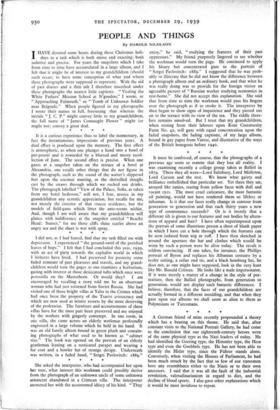It must be confessed, of course, that the photographs of
a previous age seem so remote that they lose all reality. I was examining recently a college group taken at Balliol is 1879. There they all were—Lord Salisbury, Lord Midleton, Lord Curzon and the rest. We know what gaiety and brilliance embellished that particular set. Yet there they sat,- arrayed like zanies, staring from yellow faces with dull and vacant eyes. The most cruel caricature, the most fantastic oil painting, would not have rendered them so lifeless or inhuman. Is it that our faces really change in contour from generation to generation and that each thirty years a new type of countenance succeeds? Or is it merely that a different tilt is given to our features and our bodies by altera- tions of apparel and hair? I have often superimposed upon the portrait of some illustrious person a sheet of blank paper in which I have cut a hole through which the features can be seen isolated from wig or ruff. I have then sketched in around the aperture the hat and clothes which would be worn by such a person were he alive today. The result is seldom convincing. If one takes, for instance, the Phillips portrait of Byron and replaces his Albanian costume by a reefer suiting, a collar and tie, and a black homburg hat, he does not, as one might have supposed, look in the very least like Mr. Ronald Colman. He looks like a male impersonator. If it were merely a matter of a change in the style of por- traiture, then the Balliol photographs, from generation to generation, would not display such fantastic differences. I believe, therefore, that the faces of our grandchildren are actually formed in a different moulding, and that when they gaze upon our albums we shall seem as alien to them as Polynesians or Turcomans.






























 Previous page
Previous page